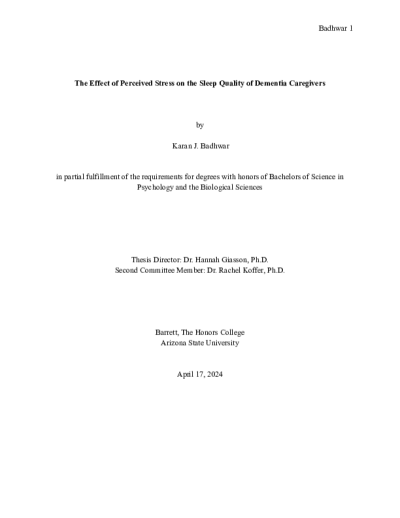Filtering by

My efforts have culminated in the creation of the website mentalhealthinindia.com that can be used as a resource both by people in India as well as those abroad who are curious to learn about the stigma surrounding depression and differently abled children in India.

The relevance of depression in the clinical realm is well known, as it is one of the most common mental disorders in the United States. Clinical depression is the leading cause of disease for women worldwide. The sex difference in depression and anxiety has guided the research of not just recent studies but older studies as well, supporting the theory that gonadal hormones are associated with the mechanisms of emotional cognition. The scientific literature points towards a clear correlative relationship between gonadal hormones, especially estrogens, and emotion regulation. This thesis investigates the neural pathways that have been indicated to regulate mood and anxiety. Currently, the research points to the hypothalamic-pituitary-adrenal axis, which regulates the stress response through its ultimate secretion of cortisol through the adrenal cortex, and its modulated response when exposed to higher levels of estrogen. Another mechanism that has been investigated is the interaction of estrogen and the serotonergic system, which is noteworthy because the serotonergic system is known for its importance in mood regulation. However, it is important to note that the research seeking to determine the neurobiological underpinnings of estrogen and the serotonergic system is not expansive. Future research should focus on determining the direct relationship between cortisol hypersecretion and estrogens, the specific neurobiological effects of serotonergic receptor subtypes on the antidepressant actions of estrogens, and the simultaneous effects of the stress and serotonergic systems on depressive symptoms.



Reasons to Stay Alive is a short story that follows the protagonist, Corinne Larson, and her experiences with depression and anxiety as well as self-harm and suicidal ideations. It is meant to act as an antithesis to media that romanticizes suicide, such as the television show 13 Reasons Why (2017), and instead glorify growth and healing. Specifically, it focuses on the importance of social support in the healing process. The story is separated into three different formats: narrative, letter, and free-verse poetry. It is prefaced by a poem titled ‘death by suicide’ that discusses the stigma around suicide and the reason why the phrase ‘commit suicide’ was changed to ‘death by suicide’. The story then starts with a letter written by Corinne to her future self during a time she was really struggling with depression and self-harm and suicidal ideations. It is a plea with her future self to tell her everything will be alright. The rest of the story is broken into four parts, each about a specific and important person in Corinne’s life. Each part starts off as a first person narrative from Corinne’s point of view and is a memorable experience she had with each person and ends with a short letter addressed directly to each person. The letters are a chance for Corinne to tell each person how important they are to her, how they made an impact in her life, and how they gave her a reason to stay alive. Between each part is a poem that deals with different themes relating to depression or anxiety. The story ends with a letter written by Corinne to her future self that goes back and addresses the first letter. It gives past Corinne some words of advice and tells her that her reasons to stay alive are the important people in life as well as herself and the person she will become.


Homeless individuals encounter barriers such as lack of health insurance, increased cost of care and unavailability of resources. They have increased risk of comorbid physical disease and poor mental health. Depression is a prevalent mental health disorder in the US linked to increased risk of mortality. Literature suggests depression screening can identify high-risk individuals with using the patient health questionnaire (PHQ-9).
The objective of this project is to determine if screening identifies depression in the homeless and how it impacts healthcare access. Setting is a local organization in Phoenix offering shelter to homeless individuals. An evidence-based project was implemented over two months in 2019 using convenience sampling. Intervention included depression screening using the PHQ-9, referring to primary care and tracking appointment times. IRB approval obtained from Arizona State University, privacy discussed, and consent obtained prior to data collection. Participants were assigned a random number to protect privacy.
A chart audit tool was used to obtain sociodemographics and insurance status. Descriptive statistics used and analyzed using Intellectus. Sample size was (n = 18), age (M = 35) most were White-non-Hispanic, 44% had a high school diploma and 78% were insured. Mean score was 7.72, three were previously diagnosed and not referred. Three were referred with a turnaround appointment time of one, two and seven days respectively. No significant correlation found between age and depression severity. A significant correlation found between previous diagnosis and depression severity. Attention to PHQ-9 varied among providers and not always addressed. Future projects should focus on improving collaboration between this facility and providers, increasing screening and ensuring adequate follow up and treatment.

This narrative literature review explores how perceived stress affects sleep quality in dementia caregivers by examining various factors. Ten studies from 2013 to 2022 across four continents were analyzed, focusing on caregiver stress levels, sleep quality, caregiver burden, and depression. Higher stress levels were linked to poorer sleep quality, alongside factors like emotional distress and disrupted sleep patterns. The findings highlight the importance of targeted interventions to reduce stress and improve sleep quality among dementia caregivers, suggesting the need for longitudinal and empirical studies with standardized measures for a better understanding.